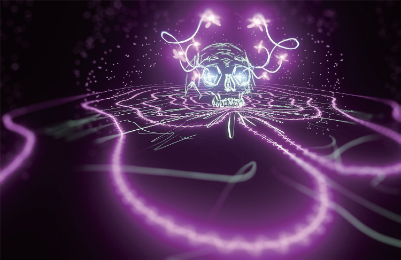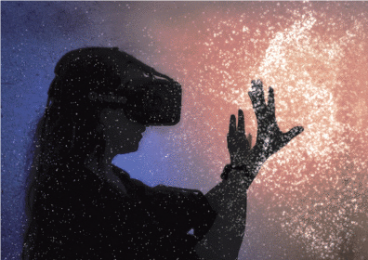On February 7th, the 2018 PyeongChang Winter Olympic Games held its first IT opening ceremony with the ‘1218 Drones Show’, receiving worldwide attention. As introduced on the website, the 2018 PyeongChang Winter Olympics was not only about sports, but also a “celebration of culture, an ‘Everyday Culture & Festival’.” New technologies such as Virtual Reality (VR) and Augmented Reality (AR) were combined with cultural contents during the Olympic Games, which became an opportunity to showcase Korea’s-advanced technologies and artistic capabilities to the spectators from around the world. Likewise, artists also have been taking notice of the VR technology as a new medium for their art activities recently. The Sungkyun Times (SKT) now introduces the advancement of the VR technology which brought up a big change in the era of the Fourth Industrial Revolution, the various fields of art utilizing it, and the possible impact of it on the contemporary art in the future.
VR ART – Challenge of the 21st Century Modern Art
Collaboration Between Art and VR
Through VR technology, users can experience a “virtual reality”, as real life is simulated through the visual, auditory, and tactile augmentation by computer technology. As VR technology extended beyond the IT field into Art, artworks made through VR technology are becoming the mainstream of Modern Arts lately. VR technology was first introduced to the field of art in 1960s, by film director Morton Heilig, who used his own devices to add elements of sound, smell, and touch to his movie. Introduction of a new, advanced technology can be an opportunity to break down the boundaries of the existing genres and pioneer new ones. Billy Clark, an American art director, said VR technology would help the audience develop art in the future, allowing them to be reborn as artists who are active speakers rather than passive viewers.
Various Genres of VR
1. VR Painting
Tilt Brush, one of the VR painting tool, is a digital brush connected to a VR headset. It is a revolutionary tool that shows realistic artworks to the audience by implementing the artists’ inspiration in a virtual reality, changing the static field of art more dynamically and realistically. The biggest feature of VR painting is that people can create their own world in virtual reality even with materials that would be difficult to use in reality, such as light and fire. British VR painter Liz Edwards, for example, is looking forward to a new art scene through the extension of the range of content available to the user, from creative 3D snapshots to immersive games.

2. VR Sculpture
For sculptors, VR technology can be a useful tool that would enable them to go beyond the limits of reality. Sculptors armed with futuristic headsets, motion sensors, and specially designed interfaces are now creating new artworks outside the existing studios. Monsters sculptured by VR technology have already featured in Hollywood movies such as Avengers and Star Wars. Sculptures are no longer bound to their traditional forms in which physical limitations exist. Sculpting in the virtual world, artists can still carve looks and feelings that were not contained in their works previously.

3. VR Performance
Virtual spaces created by various technologies such as holograms, AR, and VR are now being used as the stages for the performing arts. COLAB, an audience-participation theater company in London, draws the audience into the narratives of its performances, assigning a character to every audience member. Some viewers use a VR headset to follow the journey of death, while others use AR technology to watch different scenes. The more technology gets into the arts, the greater the role of the audience becomes in a performance or a play. Furthermore, in order to create various senses on the virtual stage and make sure the audience can fully immerse themselves in the work, VR performance artists block impeditive surroundings as much as possible.

Significance of VR Art in Modern Art
Freedom of Expression Beyond Two-Dimensional (2D) Frame
Barriers between the art and the audience are removed in the virtual space where physical limits of the real world are overcome. Artists cope with the technical limitations of the real world by moving away from paper and pencil or sculpture and knife. Since there is no restriction in preparation of any performance or scenario, artists can fully express their intention in their works. Canadian VR sculptor Gio Nakpil, for example, created scenes within VR which allow the audience to feel as if they were standing in front of a 9-feet ogre. His work was able to convey a profound emotion that could not be expressed in the real-world. In particular, in terms of exhibiting artworks in a museum, a new way of presenting the works beyond the wall can be devised; the audience may react differently to the same works. Moreover, users can enjoy artworks more vividly by incorporating impressive virtual reality elements.
Interaction Between Artworks and the Audience
By wearing a special VR headset, the audience can enjoy realistic graphics and sound in VR artworks. The audience can place themselves into new environments and interact with the artworks unlike their prior passive attitudes toward viewing. To enjoy “Sentient Flux” (VR painting) produced by American VR artist Nicola Plant, the audience has to wear a VR headset, stand in front of a motion sensing camera and then communicate with moving objects while moving. In this new environment, the audience can feel as if they are in an underwater cave, experiencing the feelings that Plant has experienced while snorkelling in Cambodia.
Creation of New Value in Art Market
Thanks to the development of VR art, not only artists but also creative programmers or software artists have been discovered. Due to the characteristics of VR, a lot of young artists and experimental programmers are collaborating nowadays. Competitive VR artworks not only allow the audience to be perfectly immersed in the works, but also distinguish themselves from other works and create their own added value. As VR art has gained in popularity recently, collectors around the world started to seek them, creating a boom in the VR art market. The price of VR artworks is rising rapidly due to the trend of art collaboration between famous contemporary artists and technology companies.

Disputes over VR Art
Even though the collaboration between VR technology and art industry created such wonderful results, there are still some legal and ethical controversies over VR Art.
1. Conflicts over Copyright Registration
In VR Art, credit for the creator of any work is no longer limited to the artist alone. Conflicts of copyright registration have arisen as it became harder to distinguish the actual owner of the work. Artists want to protect their works by registering a patent and technology code to prove their copyrights, whereas VR engineers are reluctant to register copyrights, because their work secrets can be disclosed immediately as the code becomes public. In other words, artists do not feel the need for technical code protection, while software companies do. As a result, they are still holding a debate on copyright registration.
2. Existential Questions of Artworks
People started to question whether it would be possible or not to regard technical works in cyberspace as art. Some say that those are still art because artists’ imagination and inspiration are embodied in the works to express their inner world. Others, however, claim that those cannot be considered as artworks because those are just images in virtual space, not reality, created by science and technology. Boundaries of artworks are becoming blurred as technology and art combines, and discussions are under way to determine the extent of defining art.
3. Method of Transactions
The way to transact VR artworks is still a concern to a lot of people. The Acute Art Virtual Gallery, located in London, England, has adopted a membership-based revenue model which provides the users with monthly and yearly appreciation. On the other hand, Danish VR producer Khora Contemporary sells artworks at a range of 15.5 to 50 million won per piece, and the cost of production depends on the investment of individuals or cultural institutions. That is, the absence of formal discussions on how to deal with a single VR artwork which shares the interests of various parties is increasing the confusion.

VR art is still at the center of a lot of debate, primarily because of the traits of its making processes and the intertwined interests of the workers from various fields. Collaboration of high technology and art is expected to continue for the foreseeable future. Thus, legislation of related laws and the means to prevent any conflicts of interest would be necessary. It has been common that VR art tends to work with only sensational or violent images to capture the public’s attention. It is a notable change, however, that artworks which combine powerful imagery and vivid VR experiences now influence the audience and their immersion in the artworks.
